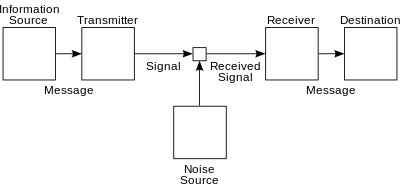Literature/1949/Shannon
< Literature < 1949| Authors | ||
|---|---|---|
|
A B C D E F G H I J K L M N
|
| |
Figures
- Fig. 1. -- Schematic diagram of a general communication system. (p. 34) [c 1]
 |
|---|
Excerpts
- The word information, in this theory, is used in a special sense that must not be confused with its ordinary usage. In particular, information must not be confused with meaning. (p. 8) [c 2]
- The fundamental problem of communication is that of reproducing at one point either exactly or approximately a message selected at another point. Frequently the message have meaning; that is they refer to or are correlated according to some system with certain physical or conceptual entities. These semantic aspects of communication are irrelevant to the engineering problem. The significant aspect is that the actual message is one selected from a set of possible messages. The system must be designed to operate for each possible selection, not just the one which will actually be chosen since this is unknown at the time of design. (p. 31) [c 2] [c 3]
Wikimedia
Related works
- Shannon, Claude E. & Warren Weaver (1949). The Mathematical Theory of Communication. University of Illinois Press. [+]
- Shannon, Claude E. (1948). "A Mathematical Theory of Communication." Bell System Technical Journal 27(3): 379-423, 27(4): 623-656.
- Wiener, Norbert (1948). Cybernetics: or Control and Communication in the Animal and the Machine. 2nd ed., The MIT Press, 1965. [+]
See also
- Cherry, Colin (1957). On Human Communication: A Review, a Survey, and a Criticism . The M.I.T. Press, 1966. [+]
Comments
- ↑ The claim for "a general communication system" appears more or less problematic. Is solving the "engineering problem" enough to take it as "general" regardless of language and its ultimatum of meaning in particular? Language problems themselves differ from their solutions as far as from logic and mathematics which are independent from their applications. Communication theory is not so psychological as applied to psychology, for example. It just appears a magic "man of a thousand faces." In spite of its names, it is indifferent to our common understanding of communication and information. From the perspective of human communication of cognition or meaning, evil is watering down the common sense; eviler is covering up the evil; evilest is insisting on it to the end.
- 1 2 While ignoring the context of "special sense" (Weaver) and "engineering problem" (Shannon), Bruner (1990) simply said, "Information is indifferent ... to meaning," hence in effect arguing against information in general. (This ignorance is as fatal as he stresses meaning.) Similar in Shannon's theory is communication used since 14c. The more popular theory of information or communication in his private sense, the more poluted usage thereof in our public sense. Cherry (1957) who titled his book On Human Communication to criticize that theory must have been unhappy about such a worsening progress!
- ↑ The main concern of communication theory may best be illustrated by sending a document at one point over the telecommunication line and receiving its closest fax image at another point, hence entirely regardless of hard cognitive tasks such as writing and reading wisely.
Notes
This article is issued from Wikiversity - version of the Tuesday, September 30, 2014. The text is available under the Creative Commons Attribution/Share Alike but additional terms may apply for the media files.